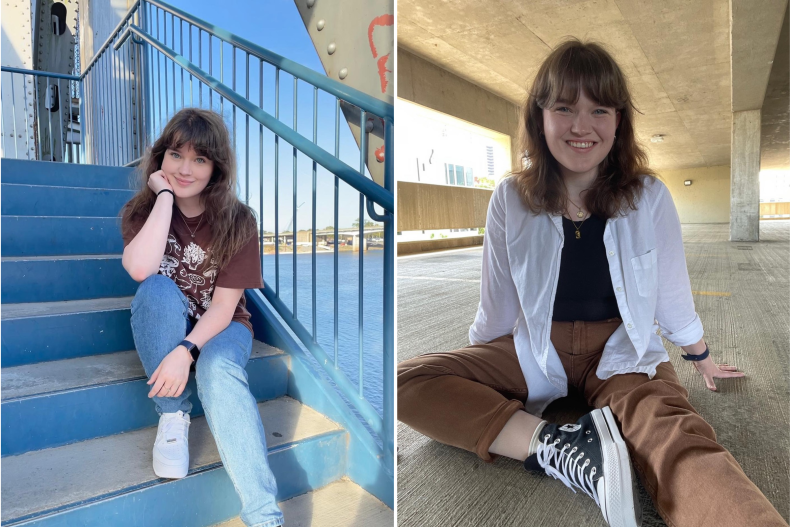In a world dominated by selfies and social media, Kat Holitik can hardly stand to look at her face. The 22-year-old has facial dysmorphia, a mental health condition similar to body dysmorphic disorder.
“I just can’t see my face,” she told Newsweek.
“I know what Selena Gomez looks like, or Hailey Bieber, or any other celebrity. Their faces are familiar to me and I can recognize and comprehend their faces in photographs but when it comes to my own face, it’s just blurry. It’s almost like a glitch.”
“I can’t perceive my body,” added Holitik, a journalism and advertising student from Arkansas.

Kat Holitik, a 22-year-old journalism and advertising student in Arkansas, can recognize celebrities’ faces in photos, but not her own. “It’s almost like a glitch,” she told Newsweek.
Kat Holitik
Body dysmorphic disorder affects between 1.7 and 2.9 percent of the U.S. population, according to Dr. Katharine Phillips, a psychiatrist who specializes in BDD.
Facial dysmorphia is considered a subset of BDD and characterized by an excessive preoccupation with perceived flaws or defects in one’s facial appearance. It is different from fleeting concerns about our looks, which many of us have.
“People with facial dysmorphia typically have obsessive and distressing thoughts about their appearance, which may not be noticeable to others or may only be minor,” clinical psychologist Gilbert Chalepas told Newsweek.
“Individuals with this condition excessively focus on these perceived flaws, often to the point where it significantly affects their daily functioning and quality of life.”
For Holitik, this manifests as difficulty navigating social events and connecting with her friends. She feels the need to be constantly vigilant in case a photograph gets snapped and finds its way onto social media.
Only one “unfavorable” image is needed to crush her mood and she forbids her friends from holding onto old pictures of her or photos that she doesn’t like.
“When I’m taking a picture of myself, it completely sets off my day because I can’t fathom that I look different from different angles. I still don’t let my friends take certain pictures of me, and I never let them post pictures of me because I always feel I look horrible,” she said.
“When I was younger, I first noticed that I couldn’t see my face in pictures and I couldn’t have them like that. I just wouldn’t let people take photos of me.”
‘It’s Always There’
The preoccupation is constant and exhausting, according to Holitik. “I would say that it’s always there, at any given second of the day, whether it’s consciously or subconsciously. Some part of me is always focused on how I look and how I’m being perceived,” she said.
“It’s crazy to me that other people don’t have this experience, because I’m constantly thinking about this.”
Chalepas said individuals with facial dysmorphia tend to experience “intense shame, embarrassment and social anxiety.”
“This can lead to the avoidance of social situations and a negative impact on relationships and overall well-being,” he added.
The causes of the disorder “can involve a combination of genetic, environmental and psychological factors,” Chalepas said. The environmental triggers include childhood experiences, social pressure and the influence of social media.
The Johns Hopkins Medicine guide to BDD states: “Bullying or teasing may create or foster the feelings of inadequacy, shame and fear of ridicule.”
Holitik finds it fairly easy to pinpoint the interactions that contributed to her developing the condition.
“It started when I was really young, in the 4th or 5th grade. I started to think that I had things to be insecure about because I was picked on very badly for some weight I’d gained from anxiety medication and for supposedly not being pretty,” she said.
When she lost a little weight she was treated very differently by her classmates, particularly the boys in her grade. This in turn encouraged her to nosedive into a lifelong obsession with her appearance.
“I got really infatuated with scales and how much I weighed from day to day.”
One incident from her schooldays sticks in her mind. At a pool day two boys began chasing her and drawing attention to her supposed excessive weight. “That was the first time that I really realized, ‘Oh, my body isn’t normal.’ And I still can’t get into my head that my body is perfectly fine.”
The preteen was caught throwing up in the bathroom at a family gathering and Holitik’s mother grew concerned. The pair visited an eating disorder clinic to be seen by a specialist.
Holitik recalls this first meeting as uncomfortable and difficult to process, but she was ultimately diagnosed with an eating disorder.
“At that time, I kept thinking that I need to be thinner. I eventually realized that no matter how thin I was, or what my skin was like, I could not see myself as skinny or pretty,” she said.
Holitik went down what she calls a “rabbit hole” of fixating on her image. Eventually, she told her psychiatrist how she felt about her face. From there she became familiar with the term facial dysmorphia.
As Chalepas pointed out, “it’s important to note that facial dysmorphia is not a simple dissatisfaction with one’s appearance, but rather a psychological disorder that leads to significant distress and impairment.”
Navigating the Digital World
A large part of Holitik’s life, as a journalism student and a young adult, revolves around social media. Her condition led her to develop a contentious relationship with the apps that dominate many of our lives. However, she now has tactics to help with this.
While her friends post selfies like there’s no tomorrow, Holitik tends to need extra reassurance to do so. This usually involves asking a friend if a photo looks OK—and then asking them a few more times to feel completely sure of their sincerity.
“When I take pictures myself I can’t fully see my face and it’s weird because I know it’s there,” Holitik said.
On social media and in life, she is beginning to understand the importance of accepting yourself, just as you are.
“It’s important to try to love yourself, and to talk openly about social media. Perfection doesn’t exist. What you see on social media is often high edited or the product of plastic surgery and fillers,” Holitik said.
“You know, people do edit their photos and do whatever they can to adhere to beauty standards.”
She added: “It’s easy to see other women online and think that they’re perfect, but all these woman have their own insecurities too. It’s ingrained in our society to compare ourselves to other women, but people should remember that they’re fine as they are and that they’re beautiful inside and out.
“Nobody needs to adhere to anyone else’s standards—and this is what I am trying to internalize myself.”
Is there a health issue that’s worrying you? Let us know via [email protected]. We can ask experts for advice, and your story could be featured on Newsweek.
>>> Read full article>>>
Copyright for syndicated content belongs to the linked Source : Newsweek – https://www.newsweek.com/body-dysmorphia-psychology-mental-health-wellness-facial-1816003













![[News] Japan Develops 10nm Nanoimprint Technology, with Potential to Tackle EUV Bottleneck – TrendForce](https://earth-news.info/wp-content/uploads/2025/12/329851-news-japan-develops-10nm-nanoimprint-technology-with-potential-to-tackle-euv-bottleneck-trendforce-360x180.jpg)
















